What is the Spiritual Meaning of the Blue Eye Symbol?
The blue eye symbol, revered for its mystical aura, serves as a potent talisman across various cultures. Often called the Nazar, it is believed to shield one from malevolent forces and negative energies.
Its deep azure hue invokes divine watchfulness, bridging the seen and unseen dominions. As an emblem of protection and spiritual clarity, it wards off envy and malice, fostering a sense of peace and security.
This ancient symbol's enduring legacy resonates with the quest for divine guardianship. The layers of its spiritual meaning will unravel deeper insights into its timeless guardianship.
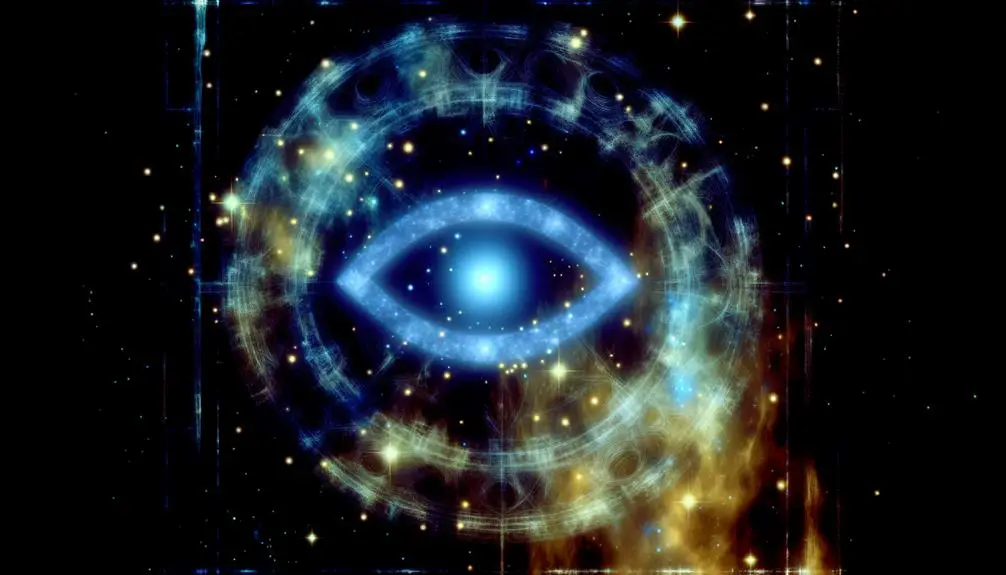
Key Takeaways
- The blue eye symbol acts as a talisman against malevolent forces, providing protection and spiritual safeguarding.
- It enhances spiritual awareness and intuition, bridging the seen and unseen worlds.
- The symbol neutralizes envy and malice, fostering an aura of security and peace.
- Its azure hue invokes divine watchfulness, creating a sense of calm and spiritual clarity.
- The blue eye's protective powers resonate across various cultures, symbolizing vigilance and guardianship.
Historical Origins
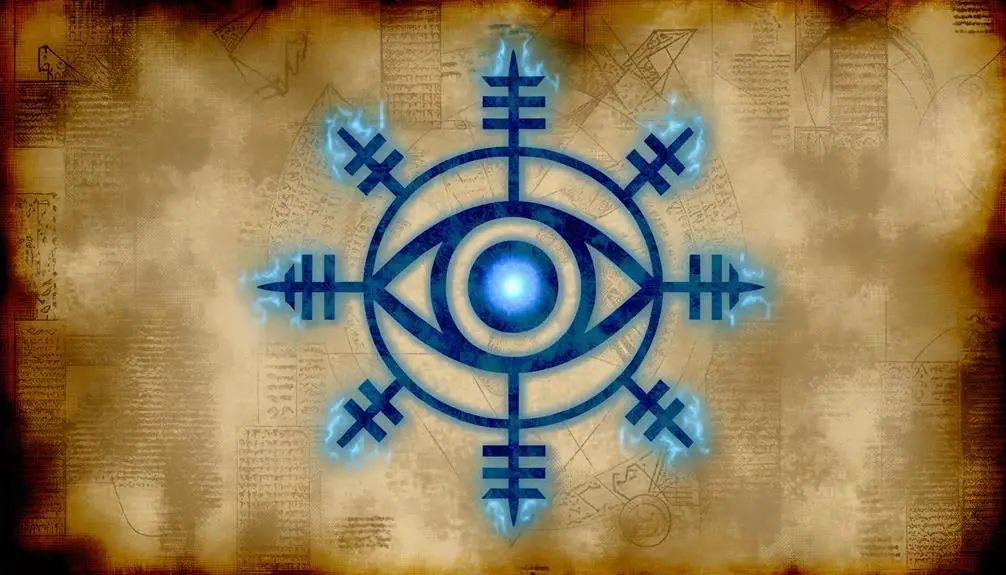
Steeped in ancient lore and timeless mysticism, the historical origins of the blue eye symbol trace back to early civilizations that believed in its potent protective powers.
In the cradle of Mesopotamia, artisans crafted amulets bearing the iconic blue eye, invoking divine favor against malevolent forces. The symbol's enchanting gaze was thought to ward off the malevolent 'evil eye,' a curse believed to be cast by envious glances.
Ancient Greeks and Romans carried the talisman, embedding it within their cultural tapestry. The blue eye's azure hue, reminiscent of the sky and sea, evoked celestial and elemental guardianship.
Through the sands of time, this symbol's enduring legacy whispers to us, echoing the ancients' quest for spiritual safeguarding.
Cultural Significance
As the blue eye symbol journeyed through the annals of history, it seamlessly wove itself into the cultural fabric of diverse societies, each attributing unique spiritual significance to its watchful gaze.
In the Middle East, it emerged as the Nazar, a talisman warding off malevolent forces. The Greeks and Romans revered it as the evil eye, a guardian against envy's dark energies. In Turkey, it became the Nazar Boncugu, a protective amulet gracing homes and personal adornments.
Across cultures, this enigmatic symbol harmonized with local beliefs, embodying a universal longing for protection and spiritual clarity. Its penetrating blue eye offered solace and a persistent reminder of the unseen forces weaving through the tapestry of human existence.
Symbolic Interpretations

The blue eye symbol, imbued with ancient wisdom, serves as a potent talisman against malevolent forces, enveloping its bearer in a protective aura.
Beyond mere defense, it acts as a conduit for heightened spiritual awareness, opening channels to deeper dimensions of intuition and insight.
Its enigmatic gaze not only shields but also enlightens, bridging the seen and unseen worlds.
Protection Against Evil
Throughout various cultures, the blue eye symbol emerges as a profound talisman renowned for its mystical ability to ward off malevolent forces and shield individuals from harm. Known as the Nazar, this emblem is believed to possess a potent, protective aura that deflects the envious gaze and ill intentions of others.
It serves as a spiritual sentinel, guarding the bearer from unseen dangers that lurk in the shadows. The deep azure hue of the eye is thought to resonate with the celestial domains, invoking divine protection and cosmic balance.
This sacred symbol, imbued with ancient wisdom, offers solace and security, fostering an environment where the soul may flourish unencumbered by the specter of malevolence.
Spiritual Awareness Enhancement
In its mysterious gaze, the blue eye symbol offers profound insights, serving as a beacon for heightened spiritual awareness and enlightenment. This ancient emblem, revered across cultures, taps into the innermost recesses of the soul, guiding one towards deeper understanding and inner peace.
The blue eye symbol can enhance spiritual awareness through several symbolic interpretations:
- Intuitive Vision: It awakens inner sight, allowing one to perceive truths beyond the physical domain.
- Divine Connection: It serves as a conduit to higher spiritual spheres, fostering a closer relationship with the divine.
- Inner Clarity: It encourages self-reflection and clarity, revealing hidden aspects of the self.
Thus, the blue eye symbol becomes a transformative tool, illuminating the path to spiritual awakening.
Protective Powers
Revered across various cultures, the blue eye symbol is often believed to possess potent protective powers against malevolent forces and negative energies. Mystical in its essence, this emblem serves as a vigilant guardian, warding off the malevolent intentions of those who harbor ill will.
Its deep azure hue is thought to mirror the boundless sky and the depths of the ocean, invoking a sense of divine watchfulness. The symbol's presence is a spiritual shield, absorbing and reflecting harm intended for its bearer. It is imbued with an almost mystical ability to neutralize envy and malice, creating an aura of calm and security.
The blue eye stands as a beacon of hope, ensuring protection and peace for those who embrace its power.
Variations Across Cultures
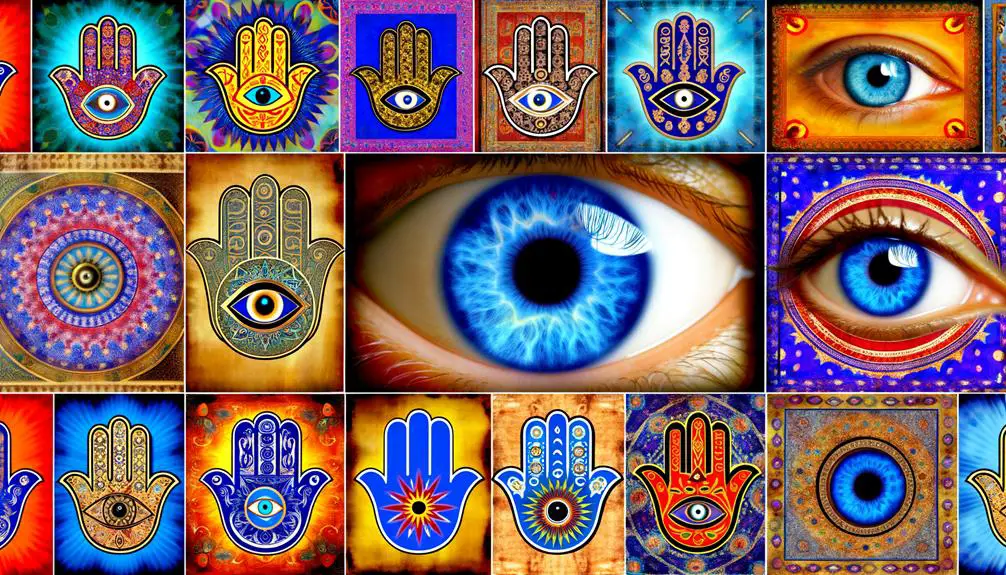
Emanating universal allure, the blue eye symbol manifests in myriad forms across diverse cultures, each imbuing it with unique spiritual significance.
In Middle Eastern tradition, the Nazar, or 'evil eye,' serves as a powerful amulet against malevolent gazes.
Ancient Greeks venerated this symbol, believing it could deflect envious stares and misfortune.
Similarly, in Turkish culture, the Nazar Boncuğu is cherished, hanging above doorways to protect homes.
- Middle Eastern Tradition: The Nazar wards off evil and misfortune.
- Ancient Greek Belief: Revered for its protective qualities against envy.
- Turkish Culture: The Nazar Boncuğu is a household guardian.
These variations, while distinct, converge in their shared belief in the blue eye's potent spiritual guardianship.
Modern Uses
In the tapestry of contemporary life, the blue eye symbol weaves its mystical essence through fashion and accessories, becoming talismans of protection and beauty.
This ancient emblem finds new expression in home décor trends, transforming spaces into sanctuaries of spiritual resonance.
Through these modern uses, the timeless energy of the blue eye continues to guard and inspire.
Fashion and Accessories
Adorning modern jewelry and clothing, the blue eye symbol has seamlessly woven its ancient protective power into the fabric of contemporary fashion and accessories. This mystical emblem, often embedded with enchanting allure, serves as both a talisman and a trendsetter. Fashion enthusiasts and spiritual seekers alike are drawn to its enigmatic charm, finding resonance in its historical depth and cultural significance.
In today's fashion world, the blue eye symbol manifests in various forms:
- Jewelry: Elaborately designed necklaces, bracelets, and earrings incorporating the symbol.
- Clothing: Patterns and prints that subtly or boldly feature the protective eye.
- Accessories: Handbags, scarves, and even footwear adorned with this ancient motif.
The blue eye symbol hence remains a beacon of protection and style.
Home Décor Trends
The blue eye symbol has gracefully found its way into modern home décor, infusing spaces with its mystical essence and protective energy. This ancient talisman, often known as the Nazar, is now a cherished motif in contemporary interiors.
Its profound symbolism is seamlessly woven into wall art, cushions, and ceramics, adding a touch of spiritual depth and cultural richness to living spaces. Homeowners and designers alike are drawn to its enigmatic presence, believing it wards off negative energy while fostering an atmosphere of serenity.
Religious Beliefs
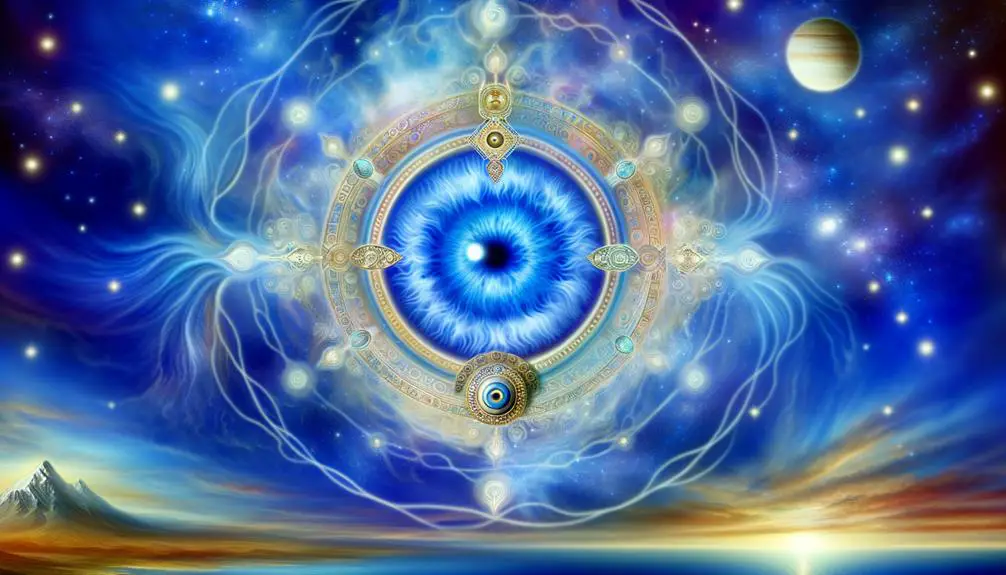
Within the tapestry of religious beliefs, the blue eye symbol emerges as a potent emblem of divine protection and spiritual insight. Its presence is a tribute to humanity's pursuit for a safeguard against malevolent forces and the desire for higher wisdom.
Across different faiths, this symbol signifies:
- Divine Protection: In Islamic culture, the blue eye, or 'Nazar', is believed to ward off the evil eye and shield the bearer from harm.
- Spiritual Awakening: In Hinduism, the third eye, often depicted in blue, symbolizes inner vision and enlightenment.
- Holistic Balance: In Christian mysticism, the blue eye can represent the omniscient gaze of God, ensuring balance and justice.
Thus, the blue eye transcends boundaries, embodying a universal longing for spiritual guardianship.
Mythology and Folklore
In the tapestry of ancient mythology and folklore, the blue eye symbol emerges as a potent talisman, believed to ward off malevolent forces and offer protection.
Its cultural symbolism varies across civilizations, yet consistently resonates with themes of vigilance and spiritual guardianship.
This mystical emblem invites us to explore the profound connections between human belief and the unseen domain.
Ancient Protective Talismans
Mystical traditions across various cultures have long revered the blue eye symbol as a potent talisman for warding off malevolent forces and attracting divine protection. The blue eye, often called the 'evil eye' amulet, serves as a vigilant guardian, believed to intercept and neutralize envious gazes and ill intentions.
Throughout history, its significance is encapsulated in numerous ancient practices:
- Ancient Egypt: Amulets known as 'Wadjet' eyes were worn to invoke the protective power of the goddess Wadjet.
- Greece and Rome: Blue eye charms, called 'matiasma' in Greek, were widely used to shield against jealousy and curses.
- Middle Eastern Traditions: Known as 'Nazar,' these talismans were crafted to deflect negative energy and invoke blessings.
Such enduring reverence speaks to its profound mystical resonance.
Cultural Symbolism Variations
Beyond its role as a protective talisman, the blue eye symbol permeates cultural mythologies and folklore, embodying a rich tapestry of meanings that reflect the collective psyche of diverse civilizations.
In ancient Greece, it was believed to ward off the malevolent glare of envy, while in Turkish folklore, the Nazar amulet safeguarded against the evil eye's curse. Egyptian lore speaks of the Eye of Horus, a symbol of protection, royal power, and good health.
Across the Mediterranean, it unites various traditions under a shared belief in its mystical guardianship. Each culture weaves its own narrative, yet the blue eye remains a universal emblem of vigilance and spiritual safeguarding, transcending geographical boundaries and epochs.
Psychological Impact
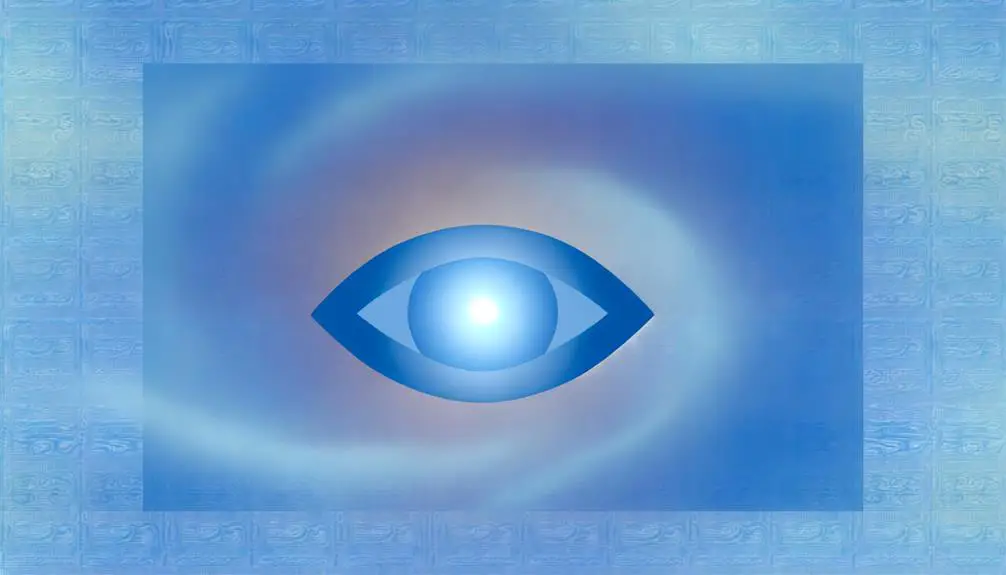
The blue eye symbol, often regarded as a talisman of protection, profoundly influences the human psyche by evoking a sense of security and warding off negative energies. This mystical emblem taps into our subconscious, offering an emotional sanctuary and fostering a tranquil mind.
The psychological impact can be categorized into three key areas:
- Emotional Resilience: It instills courage, allowing individuals to face adversities with a fortified spirit.
- Mental Clarity: The symbol acts as a mental purifier, clearing away intrusive thoughts and promoting focus.
- Spiritual Assurance: It nurtures a deep-seated belief in divine protection, soothing existential anxieties.
These effects collectively empower the wearer, weaving a protective aura that aligns mind, body, and spirit harmoniously.
How to Use It
Harnessing the protective power of the blue eye symbol involves integrating it into daily practices and personal spaces to amplify its spiritual benefits.
Place the symbol at the entrance of your home to ward off negative energies, or wear it as jewelry to carry its shielding aura wherever you go.
Meditate with the blue eye, visualizing its protective gaze enveloping you, fostering a sense of inner peace and safety.
Incorporate it into your workspace to inspire creativity and safeguard your endeavors from malevolent intentions.
Whether through adornment or meditation, the blue eye serves as a conduit of spiritual fortitude, empowering your journey with its ancient wisdom and protective essence.
Common Misconceptions
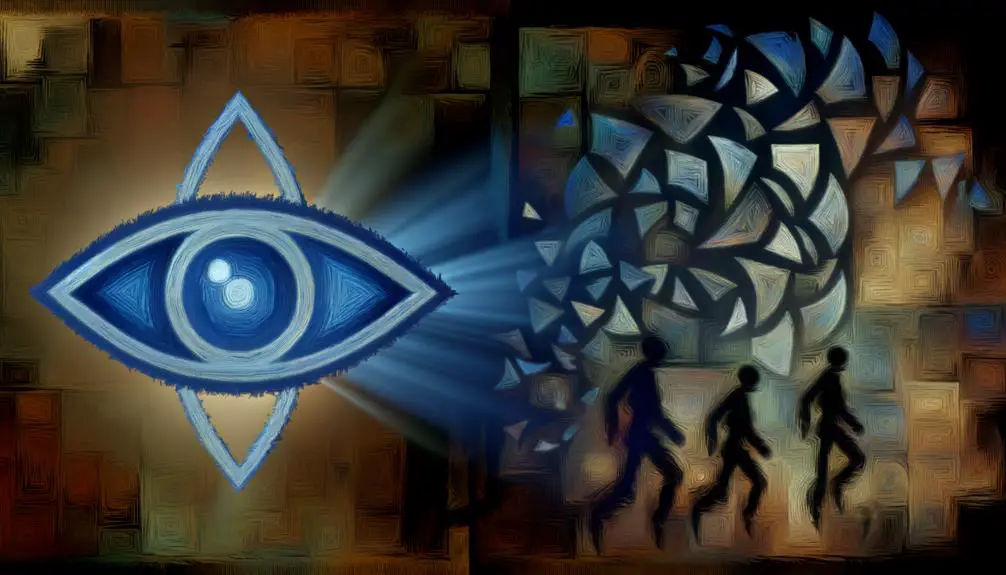
While the blue eye symbol is cherished for its protective qualities, several misconceptions cloud its true spiritual essence. Many believe it to be universally understood in its application, but this is far from accurate.
- Cultural Homogeneity: It's often assumed that the blue eye symbol holds the same meaning across all cultures, yet its significance varies widely.
- Superstitious Reliance: Some think merely possessing the symbol guarantees protection, overlooking the importance of intention and belief in its power.
- Commercial Exploitation: The symbol is frequently commodified, reducing its profound spiritual significance to mere fashion.
These misconceptions dilute the symbol's mystical depth, obscuring its true purpose: a talisman of profound spiritual resonance, requiring respect and understanding.
Conclusion
To sum up, the blue eye symbol, much like an ancient tapestry woven with threads of mysticism and cultural reverence, continues to captivate the human psyche.
Its historical roots and protective symbolism resonate across various traditions, offering both spiritual solace and psychological comfort.
The symbol's enduring presence in mythology and folklore underscores its profound impact, while its variations across cultures highlight a universal quest for protection and insight.
Misunderstandings only add to its enigmatic allure, deepening its mystical charm.






